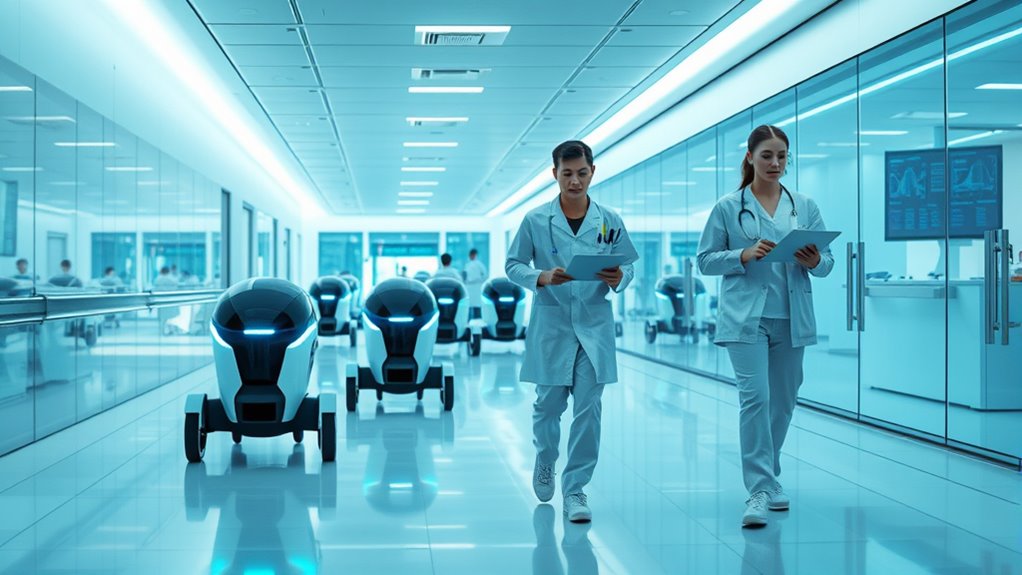AI is now automating many healthcare tasks, from diagnostics to administrative work, which raises concerns about doctors becoming less essential. While automation can improve accuracy and efficiency, it doesn’t replace the human touch, judgment, or empathy needed in patient care. Instead, doctors will likely shift toward overseeing systems and focusing on complex cases. If you want to explore how this transformation unfolds and what it means for your future in healthcare, keep going.
Key Takeaways
- AI automates administrative tasks, freeing doctors to focus on patient care and complex decision-making.
- Clinicians interpret AI outputs, ensuring human judgment remains essential in healthcare delivery.
- Oversight and ethical considerations prevent over-dependence and ensure accountability for AI-driven decisions.
- The role of doctors evolves to collaborate with AI tools, rather than being replaced entirely.
- Continuous training and regulation are vital to maintain trust, accuracy, and safety in AI-augmented healthcare.
The Rise of Autonomous Decision-Making in Healthcare
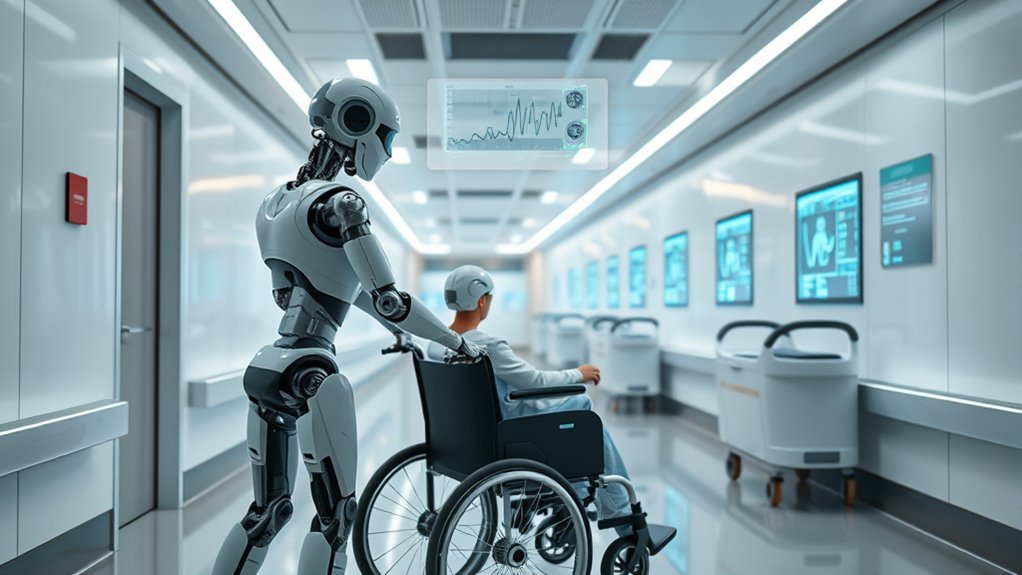
The rise of autonomous decision-making in healthcare is transforming how medical professionals diagnose, treat, and manage patient care. Today, about 80% of hospitals use AI to improve outcomes and streamline operations, with 86% of organizations reporting extensive AI use. Nearly half of US healthcare providers are in early stages of implementing generative AI, signaling rapid growth. AI now performs real-time imaging analysis, automates patient intake, and supports decision-making processes. These tools enable faster, more accurate diagnoses—such as 99.6% accuracy in ruling out heart attacks—while reducing hospital admissions by up to 50%. AI also enhances treatment planning, improves triage, and helps clinicians make better-informed decisions, all contributing to more efficient, effective healthcare delivery. Additionally, the integration of high contrast ratios in imaging systems ensures clearer, more detailed visuals that support precise diagnoses.
How AI Is Reshaping Medical Roles and Responsibilities
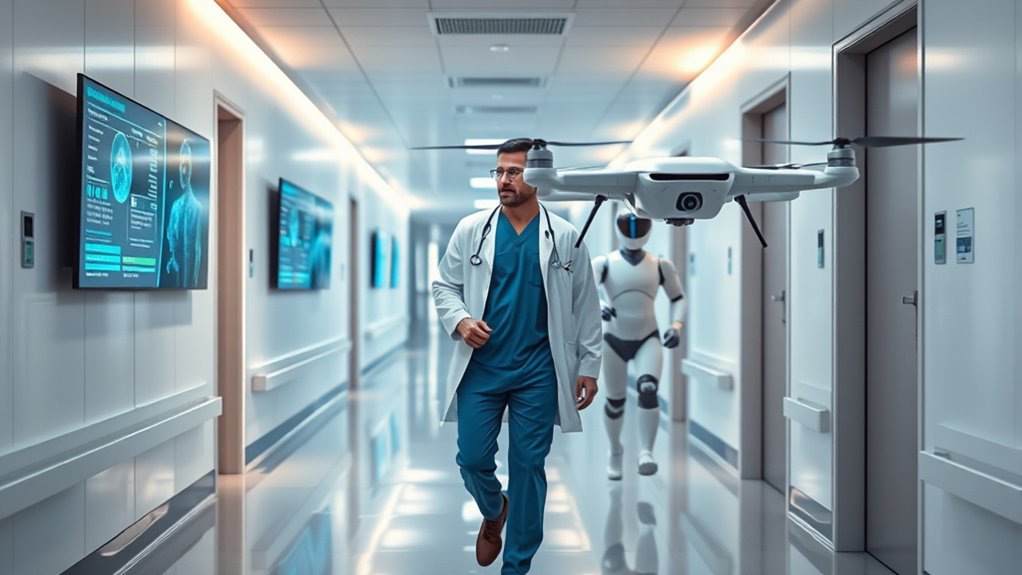
AI is fundamentally transforming how medical professionals perform their roles, streamlining workflows and enhancing decision-making. You’ll find that administrative tasks like scheduling, billing, and insurance processing are now faster and more accurate thanks to AI tools. Automated document handling reduces errors and lightens staff workloads, while chatbots and virtual assistants handle patient inquiries and appointment reminders, boosting engagement. As a result, administrative staff shift from manual tasks to overseeing and optimizing AI systems. For physicians, AI provides rapid analysis of clinical data, helping improve diagnostics and personalize treatments. Surgeons benefit from AI-augmented robotics that increase precision. Overall, healthcare professionals now interpret AI outputs and integrate them with their expertise, creating new responsibilities that emphasize collaboration with technology rather than manual execution alone. AI-driven diagnostics are increasingly assisting clinicians in making quicker, more accurate decisions, further transforming their daily practices.
Benefits and Risks of Relying on Automated Systems
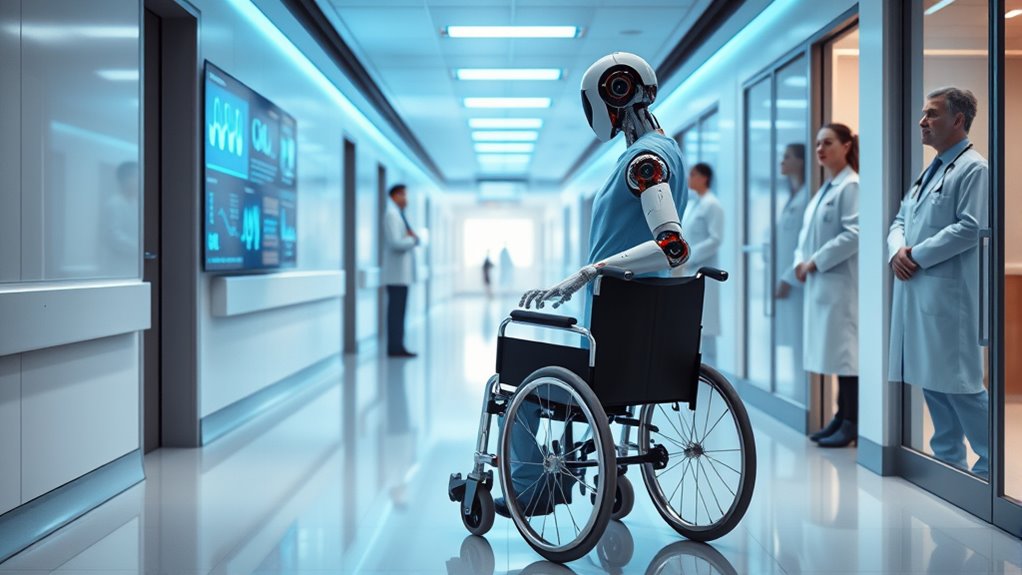
Relying on automated systems offers clear benefits like improved efficiency, reduced errors, and better patient access, but it also comes with risks like over-dependence and data privacy concerns. You need to contemplate how automation impacts clinical oversight and whether it might limit human interaction. Striking the right balance is essential to maximize advantages while safeguarding patient safety and trust. Automated systems can support healthcare professionals with real-time alerts for drug reactions and contraindications, enhancing safety and decision-making.
Efficiency Gains and Limitations
Automation in healthcare offers significant efficiency gains, transforming how medical facilities operate and deliver care. You’ll notice reduced administrative burdens as automation handles scheduling, billing, and supply management, freeing staff to focus on patient care. Automated incident response systems quickly identify and resolve issues, minimizing disruptions. Real-time data tools improve resource allocation, cut wait times, and enhance patient experiences with reminders and streamlined processes. These improvements lead to cost savings by reducing errors and optimizing resource use. However, reliance on automation introduces limitations. High upfront costs, integration challenges, and the risk of automation bias can hamper implementation. Dependence on technology might weaken human skills and pose cybersecurity threats. Furthermore, automating complex decision-making processes requires careful oversight to prevent errors that could impact patient safety. Additionally, automation reliability remains a concern, as system failures could disrupt critical healthcare functions. Balancing these benefits and risks is essential as healthcare increasingly adopts automated systems to boost efficiency.
Data Privacy Concerns
As healthcare facilities adopt automated systems to boost efficiency, concerns about data privacy grow in importance. Regulations like HIPAA aim to protect patient information, but breaches remain common—2023 saw over 133 million records exposed in 725 incidents. Nearly all patients worry about data breaches, emphasizing the need for secure practices. Automated systems can improve privacy by implementing better security measures, managing data efficiently, and performing regular compliance checks. They can also monitor data access continuously, reducing human error. However, over-reliance on automation introduces risks, such as cybersecurity threats, potential data re-identification, and lack of transparency. The Healthcare sector experienced 28.5% of all data breaches in 2020, which highlights the ongoing vulnerabilities. If these systems fail or are compromised, sensitive health data could be exposed, eroding trust and raising ethical concerns about consent and privacy.
Human Oversight Necessity
Human oversight is essential in healthcare because AI systems can make errors that lead to patient harm. You need clinicians to spot, question, and correct mistakes before they affect patients. Without human involvement, systemic errors could impact many patients simultaneously. Oversight also helps interpret AI recommendations within a clinical context, ensuring safe care. Additionally, it addresses biases and ethical issues, preventing AI from perpetuating disparities or making opaque decisions. Here are some key points:
- AI errors can cause widespread patient harm if unchecked
- Clinicians identify and correct AI mistakes
- Human oversight ensures accountability and fairness
- It mitigates biases from training data
- Oversight maintains ethical and legal standards in care delivery
Ensuring patient safety is a primary reason why human oversight remains indispensable in AI-driven healthcare. Moreover, human oversight helps manage algorithmic bias, which can skew diagnostic or treatment recommendations based on biased training data.
The Impact on Patient-Doctor Relationships and Trust

AI has the potential to reshape how patients and doctors interact by freeing up time for more meaningful, empathetic conversations. When AI handles routine tasks, you can focus more on understanding your patients’ concerns and providing compassionate care. However, trust remains vital; if AI’s decisions are opaque or untransparent, patients may become skeptical or hesitant, especially in high-risk situations or among women. Building trust requires clear communication about AI’s role and limitations. While AI can enhance shared decision-making by providing tailored information, it may also risk shifting relationships into a triadic dynamic, potentially reducing personal connection. To maintain strong bonds, you need to prioritize transparency and preserve the human elements that foster empathy and trust in clinical interactions. Understanding AI’s limitations and ensuring transparency is crucial for maintaining patient confidence and strengthening the patient-doctor relationship. Additionally, awareness of local legal resources can help address concerns related to medical malpractice or disputes that might arise from AI-assisted care.
Navigating Ethical and Regulatory Challenges
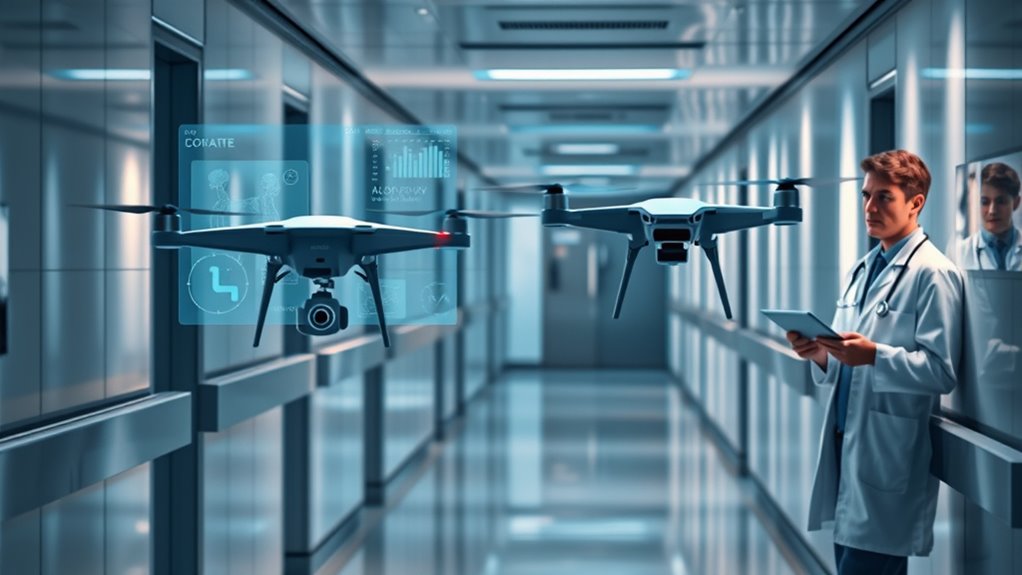
Exploring ethical and regulatory challenges in healthcare AI requires addressing a rapidly evolving landscape where innovation often outpaces existing frameworks. You face growing complexity as regulations struggle to keep up, with states leading due to limited federal laws. You must balance encouraging innovation with concerns about AI accuracy, bias, and data privacy. Compliance teams are stretched thin, relying more on tech tools to meet increasing demands. Gaps in audit readiness and oversight highlight vulnerabilities in your proactive strategies. Resource constraints further limit your ability to implement comprehensive oversight measures. You need to navigate issues like: – Risks of AI misuse, hallucinations, and transparency failures – Potential harm from over- or under-utilization – Data privacy threats from multiple tech systems – Bias, fairness, and health disparity concerns – Staff training on AI ethics and privacy to ensure responsible use; additionally, understanding the importance of regulatory compliance in safeguarding patient data and maintaining trust is crucial in this complex environment.
Preparing the Medical Workforce for an AI-Driven Future
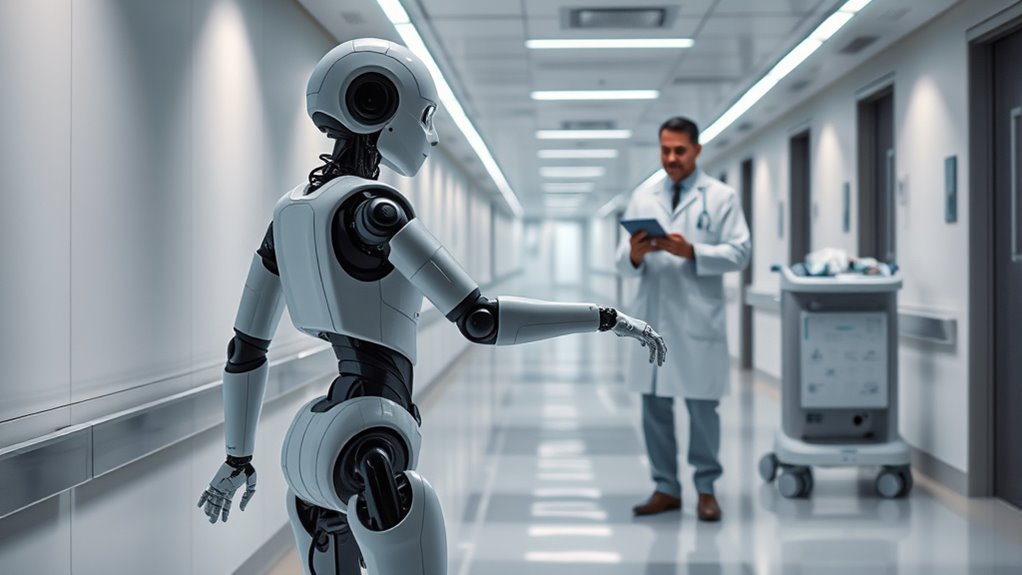
Preparing the medical workforce for an AI-driven future requires proactive strategies to guarantee clinicians can effectively collaborate with new technologies. You’ll need ongoing training and upskilling programs that help you adapt to AI-augmented roles, ensuring your clinical judgment and empathy remain central. Education curricula should incorporate AI literacy, digital health, informatics, and ethics to prepare new healthcare professionals. Embracing interdisciplinary learning will be crucial for working alongside AI tools. Tasks like administrative work are expected to be reduced considerably, freeing your time for direct patient care and complex decision-making. As AI takes on repetitive duties, roles will evolve, emphasizing collaboration rather than replacement. Staying informed and adaptable will be essential to thrive in this transformed landscape, ensuring you deliver compassionate, efficient, and technologically integrated healthcare. Additionally, understanding support hours for related technologies can help optimize integration and troubleshooting in clinical settings support hours for healthcare tools.
Frequently Asked Questions
How Will AI Impact Medical Malpractice Liability?
You’ll find AI complicates medical malpractice liability because courts struggle to assign fault when errors occur. As AI’s role grows, both healthcare providers and developers may face claims, creating legal challenges. You need to understand that AI biases, lack of precedent, and complex systems make liability ambiguous. Human oversight remains essential, but evolving regulations and legal standards will shape how responsibility is determined in AI-assisted healthcare.
Can AI Replace the Empathetic Aspect of Patient Care?
You wonder if AI can replace the empathetic aspect of patient care. While AI can simulate empathy and support communication, it can’t fully replace genuine human connection. You’re likely to find AI enhances your ability to be more present and compassionate, but the authentic emotional understanding and trust-building come from human interactions. AI acts as a tool to strengthen, not replace, the empathy that makes healthcare truly personal.
What Training Is Needed for Doctors to Work With AI Systems?
Imagine you’re preparing to captain a ship through uncharted waters. To navigate AI systems, you need core technical skills like understanding data, machine learning, and diagnostics tools. You also require training in ethics, patient communication, and regulation awareness. Continuous learning through certifications and CME modules helps you stay current. By mastering these skills, you guarantee AI becomes your trusted crew member, enhancing care while maintaining human oversight on your voyage.
How Secure Is Patient Data in Ai-Driven Healthcare?
You might wonder how secure patient data is in AI-driven healthcare. While AI can improve security through privacy analytics, machine learning, and anomaly detection, vulnerabilities still exist. Data breaches are increasing, and healthcare data is highly valuable on the black market. To protect your data, healthcare providers should implement strict access controls, data masking, and continuous monitoring, combining AI tools with human oversight for the best security.
Will AI Reduce Healthcare Costs or Increase Them?
Think of AI as a double-edged sword in healthcare costs. It has the potential to cut expenses like a sharp blade, saving hospitals billions annually through improved efficiency and reduced errors. However, the high upfront costs and data preparation expenses can temporarily increase spending. Overall, if implemented wisely, AI is more likely to reduce long-term healthcare costs, transforming the system into a more affordable and effective care delivery model.
Conclusion
As you navigate this evolving landscape, remember that every tool is only as good as the hands that wield it. Embracing AI in healthcare offers immense potential, but it’s vital to stay vigilant and ethical. Like the saying goes, “Forewarned is forearmed.” By staying informed and adaptable, you’ll help shape a future where technology enhances, rather than replaces, the human touch in medicine. Together, you can find the balance that benefits everyone.
